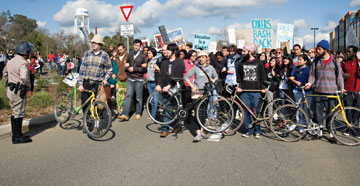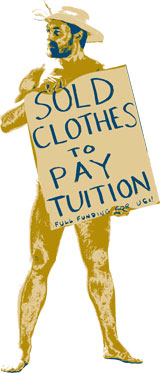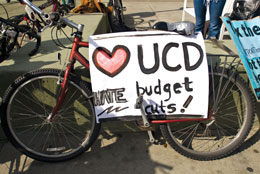Volume 27 · Number 4 · Summer 2010
Rebels With a Cause
Fee hikes and budget cuts lead to a new era of student activism.

(Photo: Karin Higgins/UC Davis)
The day of protests started March 4, like so many others before at UC Davis, with a morning rally outside the Memorial Union. But more than a dozen fire alarms pulled randomly across campus signaled something new was afoot. By the afternoon, a crowd of about 300 protesters briefly blocked Unitrans buses, then marched toward Interstate 80 with the expressed intent of stopping freeway traffic. Instead, a two-hour standoff with law enforcement officers ensued, ending with officers using batons, and Tasers and firing pepper balls to repel the oncoming crowd. One student was arrested.
Student protests are back — and on a scale reminiscent of the 1960s and 1970s, when America’s young took on issues like the Vietnam War, civil rights and apartheid. Now, they are fighting a different beast — one that threatens higher education itself.
State funding shortfalls to the UC triggered a 32 percent fee hike over two years, along with fewer and more crowded classes, sparking students to take to the streets in opposition.
On campus, students have expressed their outrage since the first day of classes.
Around the UC, the message from students and many others is clear — it is time to advocate for the UC as never before.
A Protest Precedent
Last spring’s attempt by student protestors to block I-80 traffic was not a first at UC Davis. Students protesting the Vietnam War in 1972 briefly stopped cars on the freeway, before moving to shut down the tracks of Southern Pacific Railroad.
The March 4 demonstrations, part of a “day of action” by students nationwide, followed a series of other protests on campus. During the 2009–10 academic year, UC Davis students staged a series of sit-ins in Mrak Hall, Dutton Hall, Shields Library and other buildings. Most protests were peaceful, though last Nov. 19 when a large group of students refused to leave Mrak Hall after the close of the business day, police arrested 52 people, including one faculty member. Such arrests were not unique to UC Davis — statewide, scores of student protesters were arrested last fall.
And while the March demonstration at UC Davis turned unruly, some protests at other UC campuses escalated even further. That same day, more than 150 protestors in Oakland were arrested after blocking Interstate 880, and at UC Santa Cruz, the campus closed down after protestors smashed a car windshield.
In all, more than 100 campuses in at least 33 states — including Texas, Illinois and Alabama — took part in the day’s events, according to Angus Johnston, a New York University historian who studies student activism. But nowhere was feistier than California.
“The California protests seem to be serving as a model for activists throughout the nation,” Johnston said.
“California’s campuses were at the forefront of the student movements of the 1960s, and many have remained active since.”
‘A right to be upset’
'Cordial' Campus
In 1968, when Ed Costantini was on the UC Berkeley campus, he saw National Guard troops, helicopters and tear gas used on student protestors. “I thought the world was coming to an end.”
UC Davis, known as a “cordial” campus, has witnessed its share of student protest in the past. They just have a special Davis flavor to them.
“In the 1960s, UC Davis had a nonthreatening environment and maintained its small campus atmosphere,” said Ed Costantini, professor emeritus of political science, who witnessed the Free Speech and anti-war movements from three vantage points — Berkeley, Davis and Sacramento.
If Davis back then was not quite at the epicenter of the protest universe, it might be today — as are all UC campuses, now subject to the same state cutbacks.
UC Davis Chancellor Linda Katehi has acknowledged that students “have every right to be upset and angry” about rising fees. She has urged them to take their concerns to the state Capitol — where the governor and Legislature have subjected the UC system to two successive years of deep budget cuts.

“What we do with our energy and emotion is critical to the university’s future,” Katehi said. “For all the measures in place to mitigate the fees’ impact — including expanded financial aid and a $1 billion scholarship campaign — we must, together, aggressively remind the state of its responsibilities. We must work together and make our voices heard in Sacramento.”
Students this past year tried a variety of ways to get their message across.
With looming fee hikes, program cuts and employee furloughs, hundreds of UC Davis students and their supporters organized a walk-out on the first day of classes on Sept. 24. Magali Rabasa, a cultural studies doctoral student and teaching assistant in the Spanish department, said it was an opportunity for the “outraged” to voice their support for the continued public funding of higher education.
“Education is a public good that cannot be treated as a private enterprise,” Rabasa said.
She said it is “imperative that the UC regents and the state of California protect the quality and accessibility of public education for everyone.”
Rabasa acknowledges that students must not simply preach to the choir — UC students and employees — but need to take their case for an accessible, publicly funded education to the general population and state lawmakers where budgets are set and public opinion matters.
Many faculty members side with the students, but not all agree with their tactics.
Winder McConnell, a professor of German, joined with another professor, biologist Jonathan Eisen, in an opinion column that appeared in The Sacramento Bee two days before the planned Sept. 24 walk-out. “None of us wants these miserable budget conditions and furloughs.” But, is cutting class the answer? No, they said.
“Simply put, we see it as a moral, pragmatic and political misstep for faculty to abandon their classrooms and their students,” McConnell and Eisen wrote.
On the other hand, Joshua Clover, an associate professor of English, participated in the walkout protests. Arrested at two protests this past year, he views the struggle in the UC as “a vital focus within a larger struggle against privatization.”
Clover said, “Within the university, this is a confrontation between those who live and study and work here on one side, and those who run the joint on the other. The university has a content, which is knowledge and work. That is us, that’s the public principle, the commons.”
On the opposite side, “the university has a form,” Clover said, a “corporate-model junta of bureaucrats” and a bunch of “really rich guys” who reflect the “principle of privatization” that’s behind the escalating fees, layoffs and restructuring of the UC.
“They would like to ‘re-form’ the university so it is public in name only, if that. We are the ones who say, no, that would betray the content of the university.”
Physics professor Markus Luty joined with students and gave a speech on the day of the Sept. 24 walkout rally. “The big issue is access to higher education,” Luty said later. “If we turn to a private financing model for UC, that may not be so bad for faculty and employees, but it will be negative for students because the costs will rise.”
Many of his students are the first ones in their families to go to college. “That’s a fantastic thing,” said Luty, in advocating that the UC continue to provide this kind of social mobility opportunity.

Back in the 1980s, when Luty was a student at the University of Utah, he participated in student protests on the nuclear freeze and civil rights. “But being a protestor growing up in Utah was a bit lonely,” he quipped.
Today, students are more “professionalized,” Luty said. “They are much better prepared for every facet of the educational experience, from high school on through college.”
And they have a new array of tools for organizing themselves. Students are using social media like Facebook and YouTube to spread the word, whether about an upcoming sit-in or to post pictures or video of a recent event.
Graduate student Rabasa said these Web 2.0 tools help activists organize their fellow students, but that face-to-face communications is ultimately where change takes place.
“The most significant form of communication is definitely everything that happens in personal interactions where people are encountering each other and really engaging in dialogue about the struggles we are facing,” she said.
Campus administrators this past year held several face-to-face meetings with student demonstrators.
Soon after the November Mrak Hall sit-in that ended in arrests, Katehi held a town hall meeting to talk with students about their financial hardships and what the campus is doing to help. The chancellor explained the difficulty of dealing with UC Davis’ two-year budget gap of almost $150 million. By not fully funding the UC system, the state left UC Davis with a $113 million shortfall for 2009–10, on the heels of a $33 million shortfall the year before.
“A chancellor is a chancellor for many people,” Katehi said at the meeting, “and on this campus I am the chancellor for 32,000 students, for 20,000 staff, and for 3,000 faculty and lecturers, and every single one of them is hurting. And it is very difficult to find a solution that will protect anyone in today’s environment.”
Another Kind of Protest
In early April, when UC Davis was reviewing which athletic teams to discontinue, student-athletes staged the year’s most creative protest.
In February, students organized a weekend “study-in” at Shields Library to rally in support of the library, which like other units across campus has weathered cutbacks. In the tradition of the old-style ’60s “teach-in,” the students invited speakers and held workshops on topics like civil disobedience, yoga, composting and knitting. Campus officials allowed them to hang handmade banners and posters inside and in front of the building.
In doing so, both the library and campus officials collaborated with students on what turned out to be a peaceful, teachable moment on the importance of library funding in a democratic society.
German professor McConnell said he is grateful that this year’s protests have not “degenerated” into the violence that characterized the 1960s and early 1970s. Then, America witnessed a flowering of the Free Speech Movement at UC Berkeley as anti-war protests spread to campuses around the country. The most tragic episode came in 1970 at Kent State University in Ohio, when National Guard troops shot and killed four student protestors.
During that era, McConnell was a graduate student at the University of Kansas. He said student activism then “took on a dimension that included the questioning of the very basis of American society.” In the end, he said, “ideologues” and “zealots” dominated the student protest movement, and there was not much “rational dialogue” left.

(Photo: Karin Higgins/UC Davis)
“That the students would protest the rise in student fees at a time of diminishing resources is understandable,” McConnell said. “With the exception of the intent to block traffic, the student protests that I witnessed and those that I have heard about appear to have been both responsible and civil.”
The challenge ahead — for students and UC supporters — is to speak out loudly in a way that gets results, not a backlash.
“Being involved in student activism can be an important part of their education and can lead to important lifelong involvement,” Fred Wood, vice chancellor of Student Affairs, said. He explained that the university expects students to express themselves on the “issues of the day” and to participate in our democratic society. This is part of what a well-rounded college education is all about, he added.
“We don’t consider student activism ‘bad,’” said Wood. “In fact, we generally see it as good.”
